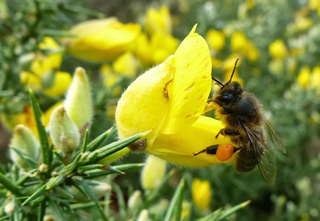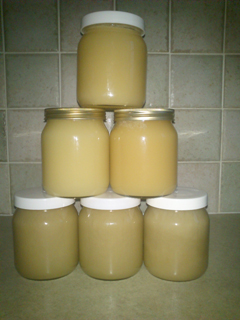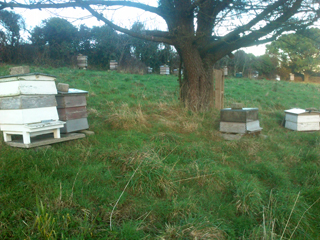 January has been an unusually warm month, resulting in the bees not being sure whether they should stay in cluster or get out and gather pollen and nectar. Both are available, witness the pollen loads coming into the hives on a sunny day – even when it is fairly cold.
January has been an unusually warm month, resulting in the bees not being sure whether they should stay in cluster or get out and gather pollen and nectar. Both are available, witness the pollen loads coming into the hives on a sunny day – even when it is fairly cold.
This is one of the major benefits of having “local” bees, in that they can cope with the local weather far better than the exotic imports from warmer climes of Europe, whether Central or Eastern. The main source of both nectar and pollen at this time of year is gorse and snowdrops, shortly to be followed by the winter aconites and crocuses. Daffodils unfortunately are not particularly attractive to bees, though they will be flowering in number shortly, with some already in bloom.
 The fact that pollen is going into the hives usually indicates both that there is a queen and that she is laying, and this is what I’m seeing with my Warré hive – the bees from this hive are always busy when others are not stirring, but whether it be the race of queen or their knowledge that they were near death’s door and are showing their gratitude, I know not! I am really looking forward to seeing them survive the winter so that I can bred from them and propagate their characteristics.
The fact that pollen is going into the hives usually indicates both that there is a queen and that she is laying, and this is what I’m seeing with my Warré hive – the bees from this hive are always busy when others are not stirring, but whether it be the race of queen or their knowledge that they were near death’s door and are showing their gratitude, I know not! I am really looking forward to seeing them survive the winter so that I can bred from them and propagate their characteristics.
 There is nothing much else to report apart from this. I am still extracting ivy honey and recently made up a new batch of creamed honey.
There is nothing much else to report apart from this. I am still extracting ivy honey and recently made up a new batch of creamed honey.
There is something about the taste of the creamed honey which gets everybody’s taste buds going – mine included! I can’t see why this honey should taste any different or better than any other type of honey (apart from a hard set variety), but it does. It must be something to do with its texture and the honey’s ability to reach or stimulate taste buds not reachable by other honeys. Anyway, it’s good to have examples of all three types of honey (four, if you include cut comb honey) and with the season we’ve just had I’ve plenty of all types. However, no two seasons are the same, so it’s useful to have adequate reserves in case of a poor harvest .
 Finally, at this time of year the indoor tasks can take priority, namely the refurbishment of hives and hive parts, the cleaning of old frames, the cleaning and processing of wax, visiting groups in the community and giving talks, and teaching some more aspiring beekeepers what they need to know to be able to start out in this craft.
Finally, at this time of year the indoor tasks can take priority, namely the refurbishment of hives and hive parts, the cleaning of old frames, the cleaning and processing of wax, visiting groups in the community and giving talks, and teaching some more aspiring beekeepers what they need to know to be able to start out in this craft.
The two classes that I’m currently running have an interesting mix of students (when was it ever any different?) and we having a lot of fun at the same time as applying ourselves to serious study. What more can a hobby offer? It’s a winner in my view.
Colin Rees – 01872 501313 – colinbeeman@aol.com

